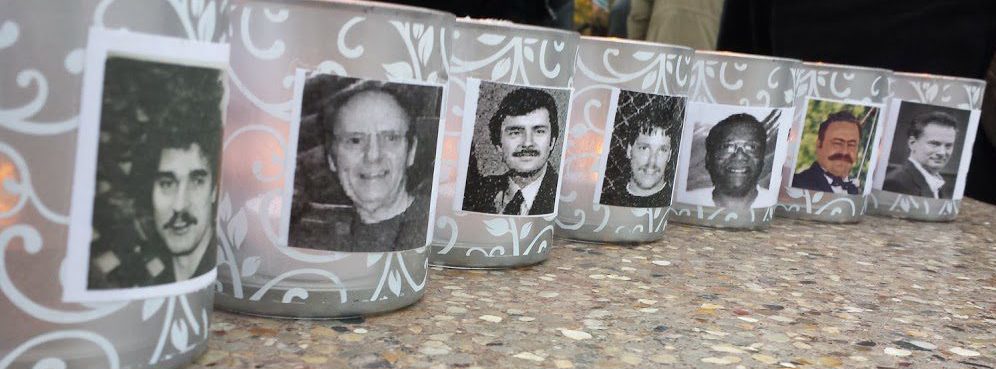A Walk for Truth; A Walk for Justice – Held on Friday, October 30, 2015 on the Brown County Courthouse steps in Green Bay, Wisconsin. For the past five years this event has transpired on or close to October 28-the day in 1995 in which six men were convicted of first degree intentional homicide for the murder of co-worker Tom Monfils at the then James River Paper Mill (now Georgia Pacific) in Downtown Green Bay.
The book (published in 2009) that caught my attention: The Monfils Conspiracy; The Conviction of Six Innocent Men, is described as such:
“Gullickson and Gaie trace the futile twenty-nine month investigation between the time of Monfils’ death and the convictions, pock-marked with dead end leads and overlooked evidence. Using solid facts, they lay bare the weaknesses, inconsistencies and secrets in the prosecution’s case and the jury’s erroneous rush to judgement. As recently as 2001, a federal judge ordered the release of one of the men, citing a lack of evidence, and further suggesting the original proof as unsound.”
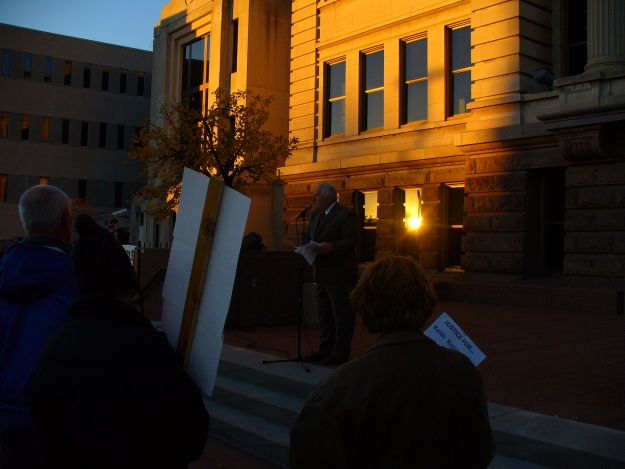
The Monfils Conspiracy author, Denis Gullickson, speaking to the crowd during the rally
I traveled over to Green Bay on Thursday, October 29th. On Friday morning, my sister Clare and I were on our way to purchase candles for the event when we received a call from John Gaie. John told me that Reporter Raquel Lamal from NBC 26 in Green Bay was looking to do a story about the rally.
“Denis is not available for an interview with her,” John said. “Could you take his place?”
I was excited to oblige so I gave Raquel a call and she offered to meet us at my sister Clare’s house. She explained her intent to show the human side of this tragedy which was great news. In addition to the interview at Clare’s house, Raquel was also at the event to broadcast live. Her piece aired on the five pm newscast following the event. Heartfelt thanks go out to Raquel Lamal for her efforts!
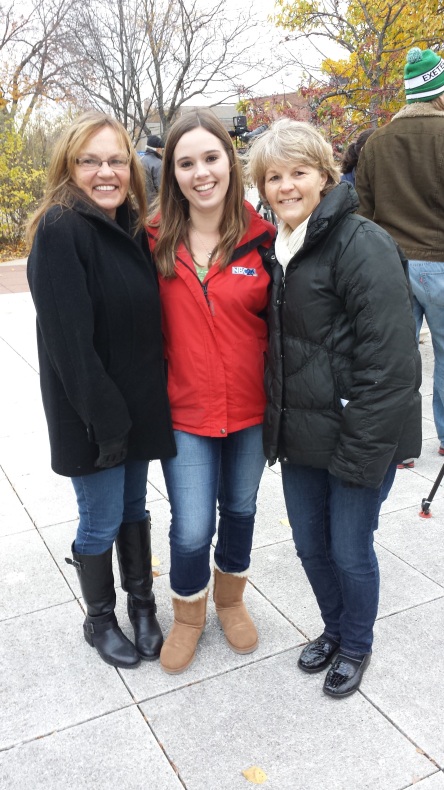
Clare Martinson, NBC 26 Reporter Raquel Lamal, and Joan at the rally
The event was filled with the usual energy and excitement. Denis Gullickson; co-author of the Monfils Conspiracy book, and emcee started things off by sharing his usual enthusiasm. He walked us through the series of activities many of us had engaged in over the years between Wisconsin and Minnesota. Much of what Denis said felt like ancient history because of the inroads we’ve made since then. Way back when, we’d forged ahead during uncertain times. It was a relief to now savor what appears to be a bright and hopeful future as each year brings additional interest and positive new developments for us to share with the local community.
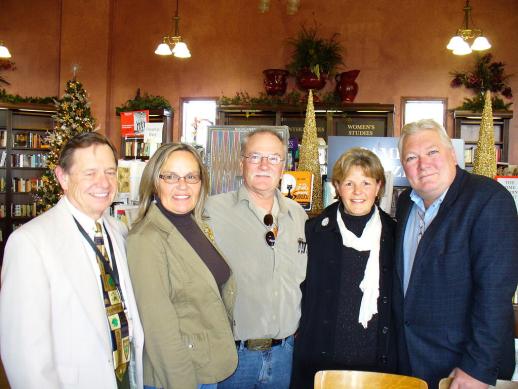
Taken in 2009 at a book signing at The Reader’s Loft Bookstore in Green Bay. (L toR) John Gaie, Clare Martinson, Michael Piaskowski, Joan Treppa and Denis Gullickson
Denis included a major development from the past year; a 152-page motion had been filed on October 31st in 2014 by lead Attorney Steve Kaplan. It was a request for an evidentiary hearing on behalf of Keith Kutska-the main suspect in the case. The hearing itself would allow the legal team to present new findings to justify a request for a brand new trial for Kutska. That motion was granted and a three-day evidentiary hearing took place on July 7, 8 and 22 of 2015. An astonishing fourteen witnesses testified to evidence that should have been brought forth at the original trial. As of November 13, 2015, there has been no word on a ruling from that hearing.

Joan in between exonerees Michael Piaskowski (L) and Mario Victoria Vasquez (R)
I delivered a much shorter speech that consisted of my gratitude for the hard work that Denis, John, and exoneree Mike Piaskowski had put into the book. I highlighted the continuance of the bravery of the families and friends of the men. I let them know they are a treasured part of my life and the focus of the inspiration instilled within me. My final thoughts were of two of my heroes standing alongside me onstage-two wrongfully convicted men who had been exonerated within that same county; Michael Piaskowski (from the Monfils case) in 2001, and Mario Victoria Vasquez, released earlier this year and who now supports our efforts to free the five remaining men. I stressed to those present that these two men represent real hope and are living proof that the other five men have a significant chance of returning home. The crowd voiced their delight and we relished in this special moment.

Family, friends and supporters touting signs carrying messages of innocence during the rally
The families and close friends of the five men had saved old signs from previous rallies and worked hard to create additional ones for us to carry during our march around the block. Signs professing the innocence of all six men were highly visible from every angle. We carried candles to illuminate this anniversary with seven of us holding special candle holders with photos to commemorate all of the men unjustly represented in this case.
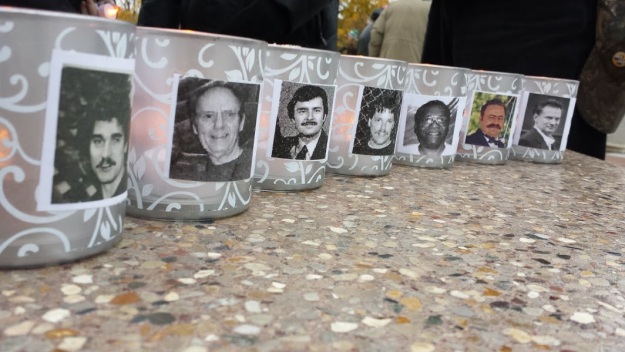
(L to R) Decedent Tom Monfils, wrongly convicted Dale Basten, Michael Johnson, Michael Hirn, Reynold Moore, Keith Kutska, and exoneree Michael Piaskowski
A few folks who were not related but had heard about the case in the news came to show their support. One of our youngest participants, Reece (orange sweatshirt), came with his Dad. Reece had read the Monfils book and insisted on showing his support by attending. Another young lady, Makayla, had contacted me a few months back expressing her interest as well. She had also read the book, attended the hearing in July and is currently doing a report on the case for school. She was not able to attend the rally that evening but said she would be with us in spirit. I believe that these young adults represent a new generation of open-minded supporters who view this overall issue in a very realistic way. And they will take its message seriously rather than exhibit apathy.

Supporters march around the city block.
These events; the motion, the hearing, and our rallies represent major milestones after twenty-three years of setbacks and denials from prior failed attempts to appeal the verdicts. There’s feelings of renewed hope and encouragement for those whose lives have been destroyed, that can never be shattered. For those who have lived this nightmare, it has been nothing short of a miracle, knowing that others now believe in them and care enough to act on their behalf. Their appreciation overflows whenever we get together and their warm hugs are filled with sincere gratitude. Most importantly, the strong bond between us will never be broken. And no matter what the future holds, it will not break our slow but steady pace to true justice!
